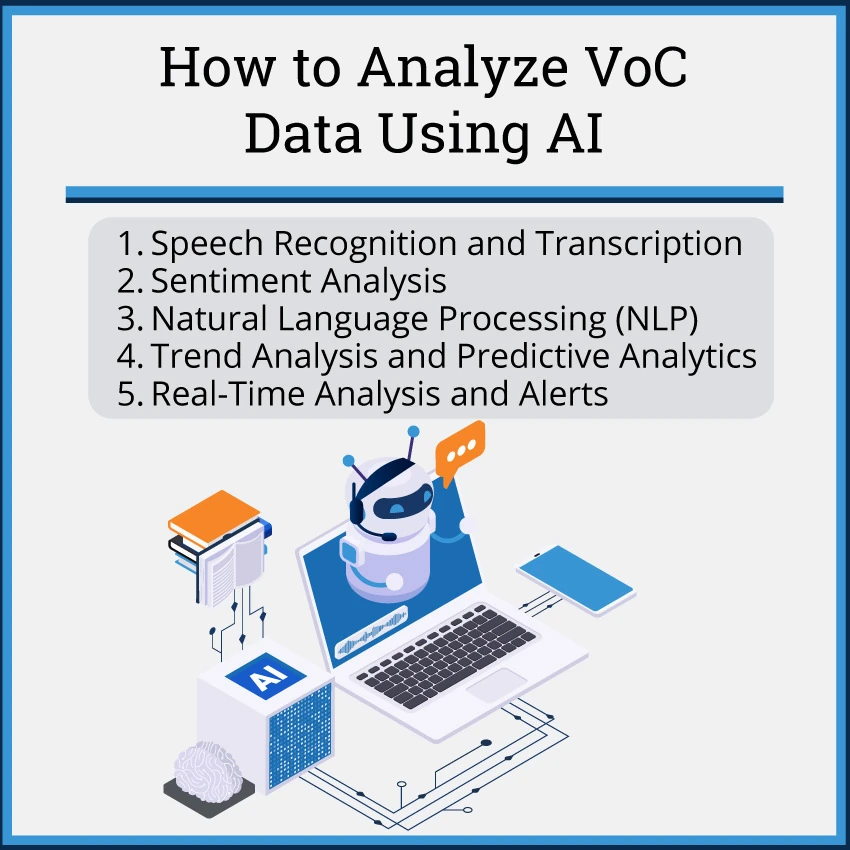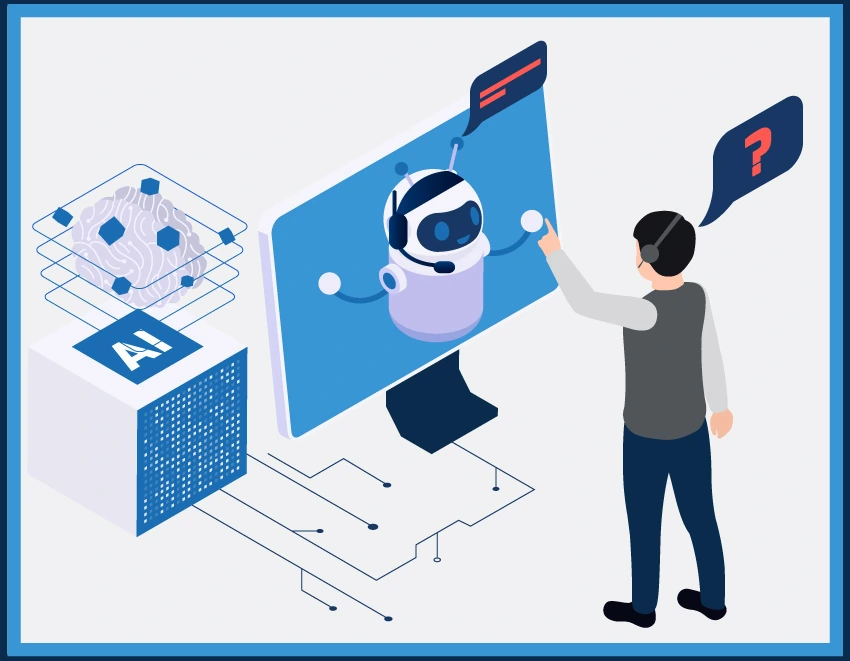Understanding the Voice of the Customer (VoC) is crucial for businesses aiming to enhance customer satisfaction and loyalty. As call centers remain a primary touchpoint for customer interactions, the vast amount of data generated through these engagements presents a goldmine of insights waiting to be uncovered.
However, manually sifting through hours of conversations to extract meaningful patterns and sentiments is time-consuming and prone to human error. This is where Artificial Intelligence (AI) is revolutionizing how businesses analyze and act on customer feedback.
AI-driven VoC analysis leverages advanced technologies such as natural language processing (NLP), machine learning, and sentiment analysis to transform raw call center data into actionable insights.
By automating the process of monitoring and interpreting customer interactions, AI enhances the accuracy and efficiency of feedback analysis and empowers organizations to swiftly address customer needs and pain points.
In this blog, we will explore the various AI technologies and methodologies employed to effectively analyze the Voice of the Customer, providing businesses with a strategic advantage in understanding and improving customer experience.
What is the Voice of the Customer?
The Voice of the Customer (VoC) is a term that encompasses capturing customers' feedback to understand their needs, desires, and experiences with a product or service. VoC data can be gathered through various methods, including surveys, interviews, social media monitoring, customer reviews, and direct interactions such as call center conversations.

Understanding VoC is vital for businesses because it provides insights that can drive improvements in products, services, and overall customer experience. By listening to the VoC, companies can identify areas where they excel and areas where they can improve.
How to Collect VoC Data?
Collecting Voice of the Customer (VoC) data involves various methods, each providing unique insights into customer preferences, expectations, and experiences. Here are some of the most common methods:
1. Surveys and Questionnaires:
a. Online Surveys: Easily distributed through email or website pop-ups.
b. Telephone Surveys: Conducted by call center agents to gather immediate feedback.
c. Paper Surveys: Often used in physical locations like stores or events.
2. Interviews:
a. In-Depth Interviews: Detailed conversations with customers to explore their experiences and opinions.
b. Focus Groups: Group discussions that provide insights into customer perceptions and attitudes.
3. Social Media Monitoring: Tracking and analyzing customer comments, reviews, and mentions on social media platforms like Twitter, Facebook, and Instagram.
4. Customer Reviews and Ratings: Collecting and analyzing reviews on websites like Yelp, Google Reviews, and product-specific platforms like Amazon.
5. Net Promoter Score (NPS): Measuring customer loyalty by asking how likely they are to recommend a product or service to others.
6. Text and Sentiment Analysis: Using AI and machine learning to analyze textual data from various sources, such as emails, chat logs, and social media, to understand customer sentiments and emotions.
Each method offers different advantages, and often, a combination of these approaches provides the most comprehensive understanding of the Voice of the Customer. By leveraging these methods, businesses can gather valuable insights to drive customer-centric improvements and strategic decisions.
How to Analyze VoC Data Using AI
AI can be leveraged to extract valuable insights, improve service quality, and enhance customer satisfaction in call centers. There are five primary ways AI can be used to analyze Voice of the Customer (VoC) data from call centers:

1. Speech Recognition and Transcription
AI-powered speech recognition systems convert spoken language in call recordings into text. These systems can handle various accents, dialects, and languages, ensuring accurate transcription of conversations.
Example: A call center for an international retail company uses AI to transcribe thousands of customer calls daily. By converting these calls into text, the company can quickly search for specific keywords or phrases related to common issues, such as "order status" or "return policy." This helps identify frequent customer concerns and optimizes the FAQ section on the company's website.
2. Sentiment Analysis
Sentiment analysis algorithms evaluate the emotional tone of the conversation by analyzing the words, phrases, and overall context. These algorithms can classify the sentiment as positive, negative, or neutral.
Example: A telecommunications company uses AI to analyze the sentiment of customer interactions in real-time. When a customer expresses frustration or dissatisfaction, the system alerts a supervisor, who can then intervene and offer additional support to resolve the issue, thus preventing potential churn.
3. Natural Language Processing (NLP)
NLP techniques analyze the transcribed text to extract key themes, topics, and keywords. This helps in understanding the main issues and recurring problems that customers face.
Example: An insurance company uses NLP to analyze call transcripts and identify common topics, such as "policy renewal," "claim status," and "premium calculation." By understanding these recurring themes, the company can streamline its processes and provide more targeted training to its agents, resulting in faster resolution times and improved customer satisfaction.
4. Trend Analysis and Predictive Analytics
AI identifies patterns and trends by analyzing historical VoC data. Predictive analytics uses these patterns to forecast future customer behavior, preferences, and potential issues.
Example: A banking call center uses trend analysis to monitor the frequency of calls related to online banking issues. During a particular month, they notice an uptick in calls regarding login problems. Predictive analytics then forecasts a continued increase in these calls if no action is taken. The bank proactively updates its online banking system and communicates the changes to customers, reducing the number of related calls.
5. Real-Time Analysis and Alerts
AI analyzes ongoing calls in real time and provides immediate insights. It can detect critical issues and alert agents or supervisors, enabling them to take prompt corrective actions.
Example: A healthcare call center implements a real-time AI analysis system to monitor calls for mentions of urgent medical issues, such as "severe chest pain" or "difficulty breathing." When such phrases are detected, the system immediately alerts a supervisor, who ensures the call is prioritized and the customer receives prompt medical advice or emergency assistance.
What are the Benefits of AI Voice Analysis in Customer Service?

Enhanced Customer Satisfaction
By using AI to analyze speech patterns, intonations, and verbal cues, call centers can more accurately gauge their customers' emotions and satisfaction levels. This allows for immediate adjustments in service strategies and problem-solving approaches, effectively addressing customer needs and concerns in real-time.
Furthermore, AI helps identify patterns or recurring issues that might be affecting customer experiences, enabling proactive measures rather than reactive responses. This means a more satisfying encounter for customers—one that fosters loyalty and promotes positive feedback.
Improved Efficiency
Using AI for voice analysis significantly ramps up the efficiency of call center operations. It notably reduces agents' time on calls by providing them with real-time insights and actionable data.
AI-driven systems can suggest on-the-spot solutions to agents or even automate responses for common inquiries, drastically decreasing call handling times. Moreover, these systems can prioritize calls based on the urgency and emotion detected in the customer’s voice, ensuring that critical issues are escalated promptly. The overall impact is a streamlined workflow that not only boosts agents' productivity but also cuts operational costs.
Personalized Customer Interactions
AI-driven voice analysis is instrumental in achieving a level of personalization that was previously unattainable. AI systems can identify individual customer preferences and behavior patterns by analyzing past interactions and voice data.
This information enables call center agents to tailor their dialogue and recommendations, creating a more personalized interaction that resonates with the customer. Such customization makes customers feel valued and understood, enhancing customer engagement and satisfaction.
What are the Challenges and Limitations of AI in Voice Analysis?

Data Privacy Concerns
While AI in voice analysis promises numerous benefits, it also brings formidable challenges, particularly regarding data privacy. Call centers deal with a vast amount of sensitive information, and there are legitimate concerns about how AI systems collect, store, and use this data.
Ensuring compliance with data protection regulations such as GDPR and HIPAA is paramount to maintaining customers' trust and safeguarding their personal information against breaches.
Accuracy and Reliability
The effectiveness of AI in voice analysis heavily relies on the accuracy and reliability of the AI algorithms. Misinterpreting emotions or intents due to accent, speech impediments, or background noise can lead to inappropriate responses and customer dissatisfaction.
Continuous training and enhancement of AI models are necessary to minimize errors and adapt to the nuances of human speech. Moreover, reliance solely on technology could result in overlooking the nuanced understanding that human judgment provides.
Integration with Existing Systems
Integrating AI into existing call center systems poses significant technological and operational challenges. Legacy systems often are not designed to support AI and large-scale data analytics without substantial upgrades or replacements.
Furthermore, ensuring that AI systems work harmoniously with current infrastructures and workflows requires substantial investment, skilled personnel, and maintenance. These challenges must be meticulously managed to ensure successful implementation and to harness the full potential of AI voice analysis.
